Comfort Measures for Labour and Birth
For support persons attending births there are numerous comfort measures to assist labouring women. Although birth is a natural healthy process, it can be challenging and women do much better when those around them can provide comfort.
Penny Simkin’s 3 R’s – ‘Relaxation, Rhythm and Ritual’ is a powerful combination to comfort women during birth. Relaxation is an essential key. When women maintain a deep state of relaxation this helps to keep endorphins high and adrenaline low. Adrenaline is antagonistic to oxytocin, the love hormone, needed to initiate and sustain labour. So, consciously relaxing, especially in between surges, really supports the birthing hormones, keeping birth safe.
Slow deep breathing is one way to stay relaxed and calm, along with visualization or guided imagery to keep muscles loose & limp. The uterus contracts to open the cervix: It is valuable to focus on the opening and softening of the cervix, not the uterus tightening. If women are afraid, they tend to tense up. This can lead to an increased feeling of pain, which can cause a negative cycle of fear, tension & pain. What’s needed is to enjoy, accept and relax, welcoming each surge as it brings baby closer.
Techniques to support relaxation include using a verbal cue such as saying ‘release’, ‘relax’, or placing a hand on the woman’s shoulder to cue her to let go. Other methods are listening to relaxing music, gazing at a family photo or into a partner’s eyes, visualizing a place that one loves to be, diffusing aromatherapy oils, use of hot or cold packs or a TENS machine. Really, anything that can invoke a state of relaxation is beneficial. Hearing someone gently encouraging you, telling you how strong you are does wonders! Being in water, either the bath or shower, also greatly enhances relaxation. Melting like a pat of butter on a hot beach may work for some but not for others. Finding out what triggers relaxation for you is essential.
Nurturing, soothing touch and massage help. Long, gentle strokes down a leg, arm or back, in a rhythmic manner induces relaxation. Massaging hands or feet work well. Light touch or a firm, deliberate squeeze is best during a birthing wave. Acupressure works too. Partners can observe if the labouring woman’s muscles are tense or relaxed, whether breathing patterns are smooth or strained, facial expression is calm vs. anxious and whether her attitude is acceptance vs. resistance of contractions. Partners can then help to reframe distress related responses when necessary.
Rhythm includes any form of movement such as making large circles on a birth ball, swaying, dancing with partner, pelvic rocking on hands and knees, lunges, stair climbing etc. Even how one does massage strokes will have a definite rhythm to them and a distinct pattern to the motion, slow and even. Birthing waves ebb and flow so it’s important to match that pattern, getting attuned to the body’s rhythm.
Ritual during a birthing wave is crucial to keeping women calm and focused. Ritual means a rhythmic repetitive activity that occurs during surges. It includes some form of relaxation and the use of ‘attention focusing’, such as something tactile, auditory, visual, kinaesthetic, mental or vocal. It can mean rhythmic verbal guidance, such as counting down during the contraction, or repeating ‘just like that’, ‘perfect’, ‘don’t change a thing’, or chanting, singing, prayer, or making eye contact throughout each pressure wave. Suggestions and verbal reminders, encouragement and compliments, patience and confidence in women, immediate response to contractions and expressions of love are components of these rituals.
Rituals will occur once a labour pattern is well established. They arise spontaneously during the experience. They change during the entire process, as often they lose their effectiveness after a while, but another ritual organically occurs to take its place. Guidance from a doula or care provider can aid in knowing what particular tool could be useful. Any of these aids may or may not work at the actual time of birthing. A woman at the time may find massage or talk distracting so we take our cues from them – they lead, we follow. One can’t prepare ahead of time in the sense of we will do this during this time and this during that stage.
How couples can prepare is to learn the various relaxation techniques, comfort measures, movements & positions and practice them often beforehand. Relaxation isn’t something to first try when already in labour! It is a conscious mindful ‘doing’. Practice leading up to the birth really will support you once labour begins. As it increases in intensity, so your ability to relax will adjust to match your experience. The 3 R’s are a beneficial practice to aid in comforting birthing women. Along with the 3 R’s, when women feel safe, are undisturbed and feel a sense of personal privacy, the potential for a positive and satisfying birth experience is possible.
Debra Woods is a seasoned birth & postpartum doula who has cared for more than 750 childbearing families. She has been practicing professionally since 1989. She is also a certified childbirth educator and placenta encapsulation specialist.
Mother to one son, who was born at home, she is passionate about educating expectant parents on evidence-based birth. Her doula practice specializes in supporting couples who plan to birth at home. She loves helping families with their newborns so they can experience a smooth adjustment into parenthood. Her approach aligns with the philosophy of attachment and instinctual parenting. Debra can be reached at http://www.dakinidoula.com/ or 778-997-0753
